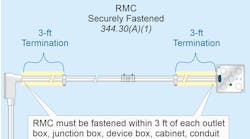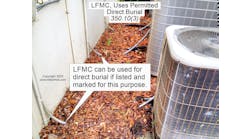Courtesy of www.MikeHolt.com
Q. What are the NEC requirements for securing and supporting PVC?
See answer below.
A. The requirements for securing and supporting PVC are found in Sec. 352.30.
PVC conduit must be fastened and supported in accordance with (A) and (B) so movement from thermal expansion and contraction is permitted.
(A) Securely Fastened. PVC conduit must be secured within 3 ft of every box, cabinet, or termination fitting, such as a conduit body (Figure).
(B) Supports. PVC conduit must be supported at intervals not exceeding the values in Table 352.30, and the raceway must be fastened in a manner that permits movement from thermal expansion or contraction.
PVC conduit installed horizontally in bored or punched holes in wood or metal framing members, or notches in wooden members, is considered supported, but the raceway must be secured within 3 ft of termination.
These materials are provided to us by Mike Holt Enterprises in Leesburg, Fla. To view Code training materials offered by this company, visit www.mikeholt.com/code.






